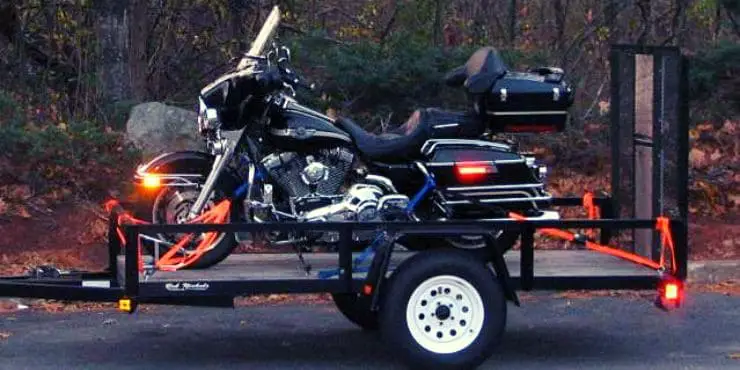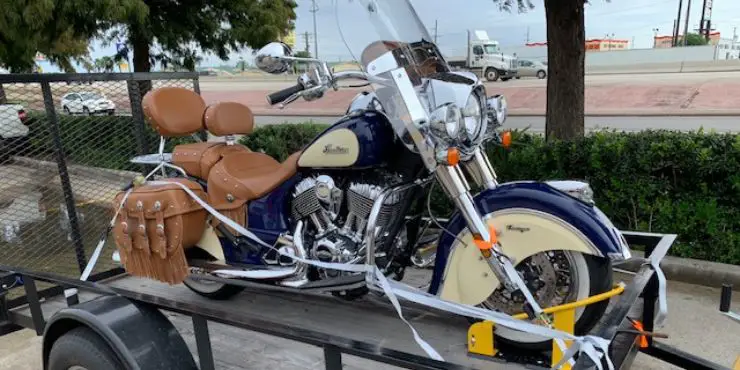Are you looking to tie down your Harley-Davidson bike on a trailer without a chock, but you don’t know how to? Don’t worry, by the time you’re done reading this article, you’ll get to know all about it.
To tie down a motorcycle without a chock, use ratchet straps to secure the front wheel by attaching straps to the handlebars or forks and anchor points on the trailer. Secure the rear by attaching straps to the frame or footpegs, keeping the bike upright.
In this article, you’ll get to know all about tying down a motorcycle, can you tie down a bike without a chock, how to tie down a motorcycle on a trailer without a chock, what is the purpose of a chock, and more. Continue reading to get all the answers that you’re looking for.
Tying down your Harley-Davidson bike safely
Securing a Harley-Davidson bike to a trailer or the back of a pickup truck is important if you’re looking to transport it safely. Without securing it properly, a motorcycle can rattle around at the back and fall out. In worst-case scenarios, it could cause injuries or fatal accidents.
Most bike tie-down guides recommend that you should use at least one chock. Wheel chocks are essentially small wedges that you have to fit under the wheels of your motorcycle, so it doesn’t move back and forth. But what should you do if you don’t have a wheel chock or don’t have the budget to buy one? You can easily tie down your Harley-Davidson bike on your trailer without a chock.
You should remember that making sure that your bike’s tires remain in place will be important when trying down your bike safely without chocks. Before you start to tie your bike down, look for an improvised chock that you can use instead of going for the real thing. A brick, a piece of wood, or a suitably shaped plastic piece can help you accomplish this goal. This will be better than completely foregoing the use of chock. Remember that you should keep your bike’s size and weight in mind. Heavier Harley-Davidson models have a lot more momentum and are difficult to bring to a stop.
Moreover, remember the more fragile chock replacement pieces may not be the job for bigger bikes.
Would it be possible to tie down your bike without a chock?
There have been numerous divided opinions about tying down a bike on a trailer without using a chock. Some would even say that it’s okay if you’re tying the motorcycle as securely as possible, and you’re only transporting your bike for a short distance.
Tying down the bike without using a chock will leave the possibility of the front wheel turning and the entire bike moving while being transported. This is especially true if you’re going to travel on a rough road, where bumps can make the wheels unstable.
If you’re looking to transport your bike as safely as possible, it’ll be best to use a chock to secure the wheels during your trip. In case you don’t have the budget to buy a metal wheel chock, you can make one from wood or any other sturdy material.

What are the possible alternatives to wheel chocks?
So, how does one tie down a bike without a chock? The first thing that you’ll need to take care of would be to keep the front wheel from turning. A chock normally does this by fitting snugly against both the rubber and the road. Without a chock, you might be able to improvise with almost any piece of plastic or wood. A brick may do the trick as well. These improvised tools will not fit perfectly, but you could compensate for it by wrapping and wedging in towels. It’ll be up to you to judge the extent to which the wheel is fixed before moving to the tie-down.
You need to keep in mind that any improvised restraint may work well for one bike but not for the other. Depending on your motorcycle’s size and weight, there will be momentum to compensate for. If you aren’t certain, you should definitely consult an expert.
How to tie down a motorcycle on a trailer without a chock
Now comes the part where you’ll need to secure and tie down your motorcycle without a chock. To do so, you should follow this process to get the best results.
- Apply soft straps to your bike, securing the ends to the sides of the trailer or the fixtures on your truck bed
- Loop each strap to a ratchet strap
- After that, compress the shocks a bit as it’ll prevent the straps from disengaging if you’re driving on a bumpy road
- Be sure that you’re picking the anchor points carefully
- To enjoy optimal results, you should use two straps at the back, two at the front, and one on each side
- You should then wrap soft straps around the bases of the left and right handlebars
- Ensure that there aren’t any slacks in the straps
- Tighten the slacks repeatedly until your motorcycle stands perfectly still, even if you have to throw your entire weight behind it
- Before taking your Harley-Davidson motorcycle on an extended trip, you should do a test drive on a short distance to see if your bike will stay in place and if nothing will move once the trailer is in motion
That’s it! As you’ll be able to see, tying down your bike on a trailer without a chock is indeed possible. However, the straps need to be ultra-secure and tight to make sure you can safely transport your bike.
The Dos and Don’ts of tying down your bike to a trailer
If you aren’t careful, the simple act of tying down your Harley-Davidson bike to a trailer could be a real hassle. It’s important to do things the right way if you want to avoid any unwarranted damages and accidents. Here are the dos and don’ts of tying your Harley-Davidson motorcycle on a trailer without a chock.
The Do’s
- You must use a high-quality ratchet strap, as it’ll help you fasten the bike properly. Moreover, it’ll keep the bike stable from all sides. Cheap straps can break off pretty quickly, causing the motorcycle to wobble around.
- Wrap the ratchet straps with soft loops for preventing the hooks of the ratchet from leaving any scratches on your motorcycle. If you’re having fixtures on the floor of the trailer, you can use them for tying the soft loops too.
- Strap down the motorcycle on two points at the rear and front wheels. At the front, you should use the front forks of the bike for the tie-down.
- As added protection for your motorcycle, consider covering it with blankets for preventing any scratches and potential damage from the material you’re using.
- Even though the odds are slim, you can keep your motorcycle in gear to minimize the damage that might occur if there’s a strap failure or in case it disengages from your self-made chock.
The Don’ts
- You shouldn’t compress the suspension of the front wheel a bit too much. You should do it partially for the front and a bit less for the gear. It’ll prevent the motorcycle from bouncing and loosening the straps when you’re driving on a bumpy road.
- You need to avoid strapping the handlebars as it could end up compressing the bushings or bending the washers. This can cause the bars to loosen.
- Remember not to throw the straps over your bike’s seat or your saddlebags, as you’ll be able to wear them down and leave marks.
- If you’re having spare material or slack from the strap, you shouldn’t leave it flapping around. Instead, you need to tie it down securely to the trailer.
- Remember not to forget to stop and perform a load check every 25-30 miles to make sure that everything is in place. It’ll be even more significant if you’ve got a long journey ahead.
Conclusion
Thank you for reading. Hopefully, now you know all about tying down a motorcycle, can you tie down a bike without a chock, how to tie down a motorcycle on a trailer without a chock, what is the purpose of a chock, and more. To tie down a motorcycle on a trailer without a chock, you’ll need to use soft straps to loop them to a ratchet strap, compress the shocks, choose the anchor points, and tighten the straps until the bike stands perfectly still. Securing your Harley-Davidson bike to a trailer would be essential if you’re looking to transport it safely. Make sure that your bike’s tires remain in place when you’re tying the bike safely without chocks.

